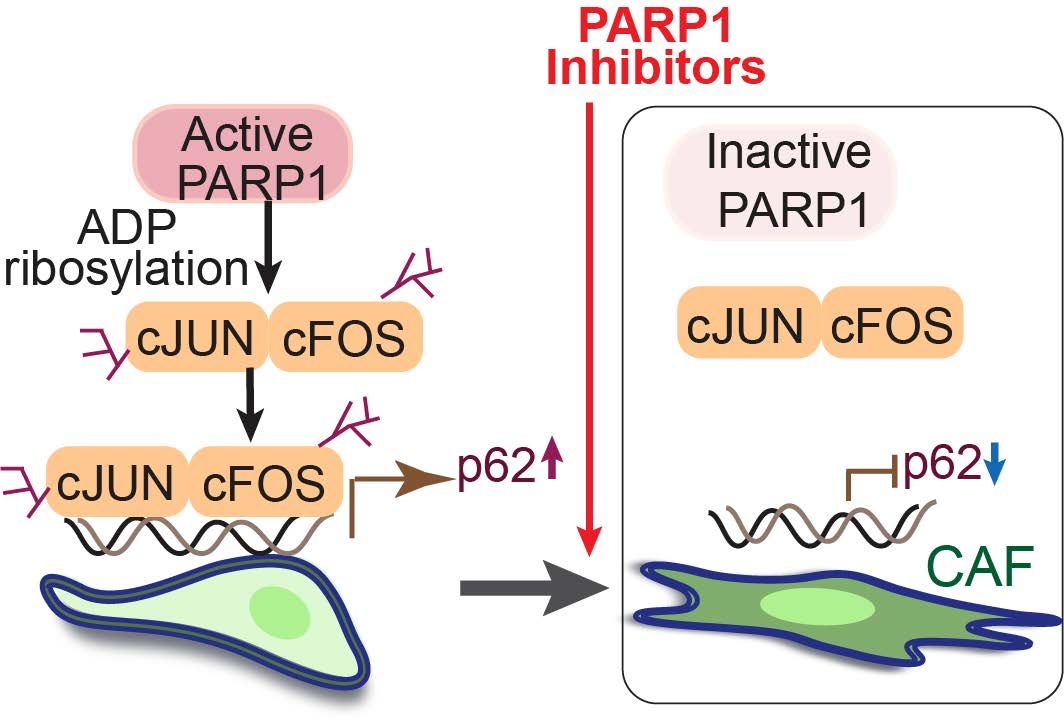Principal Investigator:
Jorge Moscat-Guillen, Professor of Pathology and Laboratory Medicine
Maria Diaz-Meco, Professor of Pathology and Laboratory Medicine
Background & Unmet Need
- Poly (ADP-ribose) polymerase (PARP) inhibitors are a class of cancer drugs which are commonly used to treat BRCA1/2 mutant ovarian and breast cancers
- However, resistance to PARP1 inhibitors is common, with more than 40% of BRCA1/2 mutant patients not responding to therapy1
- The tumor microenvironment is implicated to be a driving factor of tumor progression and treatment resistance, and activation of cancer-associated fibroblasts (CAFs) can affect treatment outcomes
- P62 is a master regulator of CAF activation, and downregulation of p62 has been shown to promote CAF phenotype in tumor stroma
- However, the mechanism by which p62 is downregulated in tumors remains unclear
- Unmet Need: Methods of inhibiting the activation of the tumor microenvironment, especially CAFs, for improved therapeutic effect and duration
Technology Overview
- The Technology:Combination therapies to increase the effectiveness of PARP1 inhibitors by inhibiting activation of tumor stroma and CAFs
- The Discovery: PARP1 inhibitors generate a feedback loop that activates CAFs by downregulating master regulator p62
- Therefore, combination treatment with a PARP1 inhibitor and an inhibitor of stromal activation may revert stroma activation and enhance anti-tumor activity
- PoC Data: Treatment with a stroma-targeted hyaluronidase significantly enhanced olaparib antitumor activity both in vitro and in vivo models of prostate cancer
- This co-targeting mechanism is applicable in additional cancers such as lung, breast, and endometrium and for combinations of PARP1 and other stromal inhibitors, such as anti-TNFa, IL-6, and JAK molecules
Technology Applications
- Combination therapy of PARP1 inhibitor with drugs targeting TNFalpha, IL-6, or Janus kinase (JAK)
- Combination therapy of PARP1 inhibitors with other drugs that target the stroma, such as hyaluronan (HA) synthase inhibitors, fibroblast activation protein alpha (FAPα) inhibitors, SMO-inhibitors, CXCL12 antagonists, or DDR2 inhibitors
Technology Advantages
- Combination therapy improves efficacy of PARP1 inhibitor therapy
- May reduce refractory rates of treatment with PARP1 inhibitors

Figure 1: Schematic depicting how PARP inhibitors activate CAFs.
Publications
Intellectual Property
Patents
- PCT Application Filed
Cornell Reference
- 10168
Contact Information

For additional information please contact
Jeffrey James
Associate Director, Business Development and Licensing
Phone: (646) 962-4194
Email: jaj268@cornell.edu

